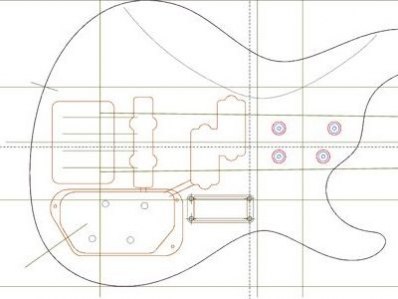QuoteA best practice is a method or technique that has consistently shown results superior to those achieved with other means, and that is used as a benchmark. In addition, a "best" practice can evolve to become better as improvements are discovered. Best practice is considered by some as a business buzzword, used to describe the process of developing and following a standard way of doing things that multiple organizations can use.
"Best Practice." Wikipedia: The Free Encyclopedia. 28 June 2015.
Adhering to some form of best practice is not a necessary pre-requisite of a useful CAD plan. In a non-professional capacity a CAD plan only has to be fit for the purpose it is intended for, rather than following an established set of standards and work templates. That said, giving a passing nod to best practice helps improve the quality and reliability of your plans, personal working methods and raising your game.
Google search results for "guitar CAD plan", "guitar dxf download", etc. reveal a hugely varying level of detailing and usefulness. Some "plans" exist as nothing more than a body outline whilst some illustrate every last part of every single component.
The answer to "which of these is better?" is not always the expected answer; neither.
You've probably already switched off by this point, wondering why you can't just draw what you need to draw and "git r done". That is exactly the point! Your CAD plan only needs to be useful for its intended purpose. The "basic body outline" example is usually because that is all the designer personally needed at the time. Overly-detailed plans ensure that every single bit of useful information for every type of end user is within that one drawing. Either that or it makes a great poster for your shop wall!
Do we need some form of best practice? No, but your CAD work will always benefit from a consistent and methodical approach, whichever of the two extremes you fall into.
A good plan generally demonstrates:
- use of guidelines and reference geometry
- grouping of parts by layer and/or colour
- straightforward representation without unnecessary detail or ambiguity
- fitness for the intended end use
- annotation, readability and easy derivation of measurements
These might seem like too much to bear in mind, however they all have a direct bearing on how well your technical drawing work translates to organising work in the shop and the final finished item. Best practice makes your CAD plans productive and useful.
Guideslines/Reference Geometry
Guitars have a very common underlying structure around which the rest of the instrument is built. For example, a centreline is fundamental to 99,99% of instruments work from. Reference geometry is the structure around which the rest of the instrument is defined. Without it, measurements become unreliable or impossible to acquire.
Grouping
Individual primitives (lines, arcs, etc.) representing a composite shape (such as a pickup rout) should be separable or at least identifiable from others. Simple colour differentiation, discrete grouping or separation by layers organise your geometry. Without grouping, complex drawings become impossible to interpret usefully.
Straightforward representation
How much information do you need in your plan? Do you need to draw all of the knurls around the nut of your toggle switch, or would it better be represented as a 1/2" circle and a centre point? Superfluous detail clouds communication of useful information. Structure, relevant grouping and useful visual communication produce easily-navigable and understandable plans.
Fitness for purpose
What is the drawing for? Does it convey required information as comprehensively and accurately as required? Does it answer any questions you may ask at build time? Is it over or under detailed?
CAD plans produced with best practice in mind are an accurate and defensible mathematical representation of the final instrument. Musical instruments are themselves based on mathematical models. Keeping that relationship from the initial design through to the shop work ensures accurate and controlled work throughout. Through subsequent articles in this series we'll mention certain useful examples of best practice which will have a direct impact on your design work. Work smart!
Designing Guitars In CAD III - Best Practice by Carl Maltby is licensed under a Creative Commons Attribution-NonCommercial-ShareAlike 4.0 International License.
You are free to:
- Share — copy and redistribute the material in any medium or format
- Adapt — remix, transform, and build upon the material
Under the following terms:
-
Attribution —You must give appropriate credit, provide a link to the license, and indicate if changes were made. You may do so in any reasonable manner, but not in any way that suggests the licensor endorses you or your use.
-
NonCommercial — You may not use the material for commercial purposes.
-
ShareAlike — If you remix, transform, or build upon the material, you must distribute your contributions under the same license as the original.
- No additional restrictions — You may not apply legal terms or technological measures that legally restrict others from doing anything the license permits.



There are no comments to display.
Join the conversation
You can post now and register later. If you have an account, sign in now to post with your account.